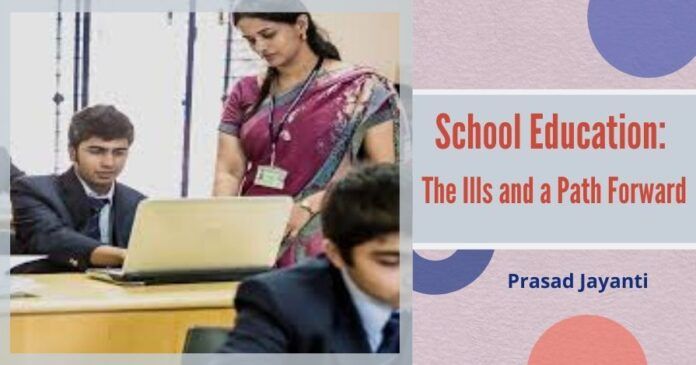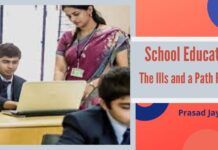
The previous part of the article can be accessed here. This is the second part.
A Vision for Success
How can schools overcome these problems and make learning so enjoyable and successful that our children, rural and urban, can aspire to study at the IITs, Princeton’s, and Harvards of the world? I believe that the following five elements constitute the answer.
1. Teach in mother-tongue.
Rationale: For children to bloom and enjoy learning, the most basic need is a climate in which they can freely interact with each other and with teachers. In the initial years of school, most children are fluent in only one language—their mother-tongue. So, if we want the child to understand what we teach, there is no choice but to use that language as the medium for instruction and interaction.
The introduction of mother-tongue as the medium in schools affirms to our children their identity and instills self-esteem.
There are three more significant reasons why schools must use the mother tongue. The foremost reason is that our languages have rich literature and culture, which the next generation deserves to inherit, and it would be an injustice to them if we don’t pass them on. Second, no one cares more for the child than parents, but in the present system parents are not able to participate in the child’s education because most don’t know English. Once we switch to teaching in the mother- tongue, families will be more empowered to engage with their child’s education, which is good for the development of the child, family, and society. Finally, the use of English from the earliest years in school perpetuates the fallacy that the English language and western culture are superior to our native language and culture, exemplified by the near-replacement of our millennia-old term of amma with mummy. The introduction of mother-tongue as the medium in schools affirms to our children their identity and instills self-esteem.
2. Teach English as a subject and teach it well.
Rationale: English is a gateway to a world of educational and career opportunities. The period of over 10 years that children spend in schools is easily enough to master English, if only schools employ proven methods like language drills and visual aids.
We won’t be alone in this approach of teaching English, but not in English: successful non-
English-speaking countries like Israel, China, Japan, Germany, and France, which are leaders in science and technology research, industry, and business have taken the same approach.
3. Emphasize concepts when teaching mathematics and science.
Rationale: In mathematics and science, real learning happens not by rote memorization, but through understanding. For example, it is not enough for second standard children to add numbers, but they should understand why adding 5 to 8 yields the same answer as adding 8 to 5. Without this understanding, the child won’t understand later the harder concept of multiplicative commutativity—why 8 x 5 and 5 x 8 are equal—and surely won’t be able to rise to understand commutativity in group and field theory much later. Concepts build on top of earlier concepts, so conceptual learning should be a priority in schools from the start.
The adoption of the mother-tongue as the medium of instruction is a great facilitator of conceptual learning since teachers would be able to convey concepts clearly and the children would understand and be able to ask questions.
I have also presented my vision of how to put our children on a track to joyful,
successful learning and prosperity.
4. Teach many dimensions of knowledge.
Rationale: The world has recognized that multi-disciplinary talent—understanding and applying principles from diverse areas of human knowledge and reconciling multiple points of view—is crucial to advancing research and development. In contrast, we in India have tended to focus on sciences, pushing other subjects to the sidelines. We must correct this trend and teach subjects such as literature, history, and civics with vigor and scope for discussion and debate. This would help children comprehend the ideas and forces that shaped and are shaping our world. We must also create opportunities for yoga, music, and sports, which stimulate the body and mind and bring peace to the heart.
5. Instill self-belief via Indian literature and Indian scientific accomplishment.
Rationale: Self-belief is necessary to realize our potential. Bharat’s priceless literature and
accomplishments in mathematics, astronomy, architecture, medicine, and chemistry will help children understand that they are heirs to timeless treasures and inspire them to rise to create wonders of their own.
For instance, all aspiring engineers study calculus with awe and admiration. Imagine the wonders it will do to their confidence when they learn that discoveries in limits and infinite series, which are the foundations of calculus, originated in India more than two hundred years before Newton and Leibniz (see Padmanabhan T., Padmanabhan V. (2019) Calculus Developed in South India. In: The Dawn of Science. Springer, Cham).
Indian literature is equally inspiring. Here are two powerful, but little-known examples. Before reading further, try coming up with a sentence (in any language) that makes sense whether you read the letters left to right, as we normally do, or from right to left. Now you will be amazed to learn of Venkatadhvari’s Sanskrit work Raghavayadaveeyam, where each of the thirty verses is not only meaningful whether you read off the letters from left to right, or from right to left, but one describes Bhagawan Sri Rama and the other Bhagawan Sri Krishna! Perhaps still more stunning is the 500-year-old Telugu work Raghavapandaveeyam of Pingali Suranna that is about 50 pages long, with the mindboggling property that the same text can be interpreted in two ways, one narrating the Ramayana and the other the Mahabharata!
6. Teach crafts.
Rationale: Crafts complement academics. Both are needed for society’s progress, and both fetch prosperity and fulfillment to the pursuer. Some children are cut out for academics and some for crafts, and it is often not possible to predict early where one’s talent lies. Schools, therefore, must teach and encourage various crafts, allow children to discover where their passion and abilities lie.
Conclusion
I have shared the problems that I observed first hand of how our schools are approaching
education. I have also presented my vision of how to put our children on a track to joyful,
successful learning and prosperity. My conviction in this vision comes from having taught and engaged with thousands of the brightest students from all over the world, including the USA, India, China, Israel, and Europe, who come to study at Dartmouth, an Ivy League university where I have been a professor for 26 years. I have also employed this vision to great success not only at the camps I described, but also with my two children who have pursued their undergraduate and graduate degrees at Dartmouth, Princeton, and MIT and, despite being born and raised in the United States, are as fluent as I am in Telugu, and more familiar with Sanskrit than I am. I have no doubt that this approach will lead to a confident, prosperous, and enlightened society that maintains its civilizational continuity, drawing strength from its glorious past and surging forward to occupy its rightful place in the world as a Vishwa Guru.
Note:
1. The views expressed here are those of the author and do not necessarily represent or reflect the views of PGurus.
- English medium in public school education: The Ills and a Path Forward – Part 2 - December 17, 2019
- English medium in public school education: The Ills and a Path Forward – Part 1 - December 15, 2019








